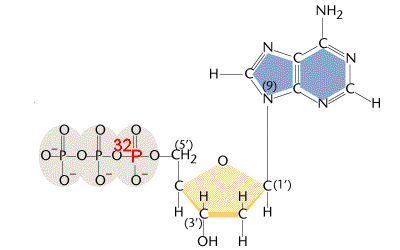
32P-labelling of DNA
For use in autoradiography, especially as
applied to DNA sequencing reaction before the
advent of fluorescent labeling techniques, a
radioactively-labelled dNTP
molecule is synthesized with the first ("alpha") PO4 containing radioactive 32P
rather than non-radioactive 33P. During synthesis of the new
DNA strand, the outer two PO4 groups are cleaved off and the labelled PO4 is incorporated into the DNA
backbone.
An alternative method of labeling substitutes 35S for the
ester-bonded O atom on the alpha PO4
and leaves the P unlabelled. This has the advantage
of a longer half-life that allows longer exposures.
It is also less radio-energetic so as to leave finer
lines in the DNA ladder (it doesn't penetrate the
film as well). This also makes 35S
safer to handle.
NB: Technical Note: Both radio-isotopes are β (Beta)-emitters.
32P
has a radioactive half-life of 14.2 days,
and breaks the PO4
group when it decays, such that it is not available for
the labeling reaction. This means that it is necessary
to increase the specific
activity of the labeling reaction over
time, for example twice as much label needs to
be added when it is one half-life (14.2 days)
old to get the same signal strength. In practice, new
label needs to be ordered once a month.
35S
has a half-life of 87.4 days (six times that
of 32P), and
being linked to the alpha-PO4,
does not remove it on decay. The good news is
that specific activity of the label need not be
adjusted over time. The bad news is that you
couldn't anyway, because a decayed molecule
participates in the labeling reaction just as well
as the radioactive label.
All text material © 2024 by Steven M. Carr